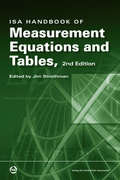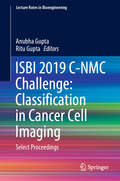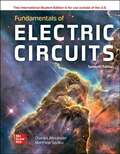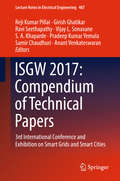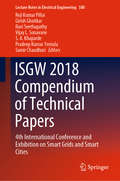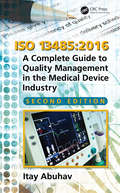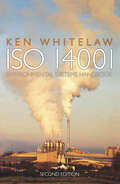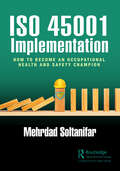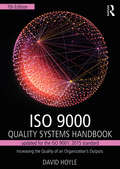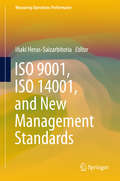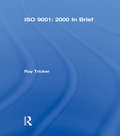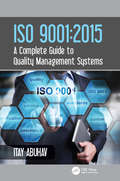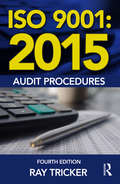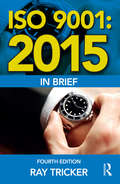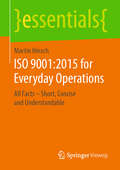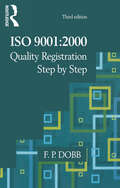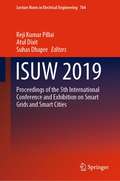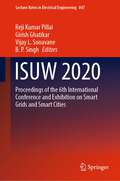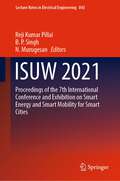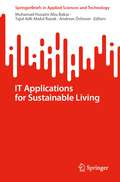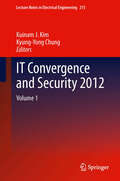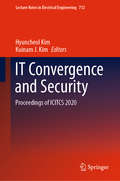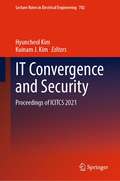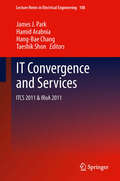- Table View
- List View
ISA Handbook of Measurement, Equations and Tables, Second Edition
by Jim StrothmanThis updated, expanded, and improved version provides hundreds of essential equations and tables to help you select, operate and maintain measurement devices. The 2nd Edition adds brand new chapters packed with tables and equations for Industrial Communications Buses, Safety, and Environmental Measurements. Tables and equations have been added to all the previous edition's chapters covering Units of Measurement, Pressure, Flow, Temperature, Level, Humidity, Electrical and Viscosity measurements.
ISBI 2019 C-NMC Challenge: Select Proceedings (Lecture Notes in Bioengineering)
by Anubha Gupta Ritu GuptaThis book comprises select peer-reviewed proceedings of the medical challenge - C-NMC challenge: Classification of normal versus malignant cells in B-ALL white blood cancer microscopic images. The challenge was run as part of the IEEE International Symposium on Biomedical Imaging (IEEE ISBI) 2019 held at Venice, Italy in April 2019. Cell classification via image processing has recently gained interest from the point of view of building computer-assisted diagnostic tools for blood disorders such as leukaemia. In order to arrive at a conclusive decision on disease diagnosis and degree of progression, it is very important to identify malignant cells with high accuracy. Computer-assisted tools can be very helpful in automating the process of cell segmentation and identification because morphologically both cell types appear similar. This particular challenge was run on a curated data set of more than 14000 cell images of very high quality. More than 200 international teams participated in the challenge. This book covers various solutions using machine learning and deep learning approaches. The book will prove useful for academics, researchers, and professionals interested in building low-cost automated diagnostic tools for cancer diagnosis and treatment.
ISE Fundamentals of Electric Circuits
by Charles K. Alexander Matthew SadikuFundamentals of Electric Circuits continues in the spirit of its successful previous editions, with the objective of presenting circuit analysis in a manner that is clearer, more interesting, and easier to understand than other, more traditional texts. A balance of theory, worked & extended examples, practice problems, and real-world applications, combined with over 580 new or changed homework problems complete this edition. <p><p>Robust media offerings renders this text to be the most comprehensive and student-friendly approach to linear circuit analysis. The seventh edition retains the "Design a Problem" feature which helps students develop their design skills by having the student develop the question, as well as the solution. There are over 100 "Design a Problem" exercises integrated into problem sets in the book.
ISGW 2017: 3rd International Conference And Exhibition On Smart Grids And Smart Cities (Lecture Notes In Electrical Engineering #487)
by Reji Kumar Pillai Girish Ghatikar Ravi Seethapathy Vijay L Sonavane S A Khaparde Pradeep Kumar Yemula Samir Chaudhuri Anant VenkateswaranThis book presents selected articles from INDIA SMART GRID WEEK (ISGW 2017), which is the third edition of the Conference cum Exhibition on Smart Grids and Smart Cities, organized by India Smart Grid Forum from 07-10 March 2017 at Manekshaw Centre, Dhaula Kuan, New Delhi, India. ISGF is a public private partnership initiative of the Ministry of Power, Govt. of India with the mandate of accelerating smart grid deployments across the country. This book gives current scenario updates of Indian power sector business. It also highlights various disruptive technologies for power sector business.
ISGW 2018 Compendium of Technical Papers: 4th International Conference and Exhibition on Smart Grids and Smart Cities (Lecture Notes in Electrical Engineering #580)
by Reji Kumar Pillai Girish Ghatikar Ravi Seethapathy Pradeep Kumar Yemula Samir Chaudhuri Vijay L. Sonavane S. A. KhapardeThis book presents selected articles from India Smart Grid Week (ISGW 2018), held on March 5 to 9, 2018, at the Manekshaw Centre, New Delhi, India. It was the fourth conference and exhibition on smart grids and smart cities organized by the India Smart Grid Forum (ISGF), a Government of India public–private partnership, tasked with accelerating smart grid deployment across the country. Providing current-scenario-based updates on the Indian power sector, the book also highlights various disruptive technologies.
ISO 13485: A Complete Guide to Quality Management in the Medical Device Industry, Second Edition
by Itay AbuhavSummary: This book provides valuable, effective guidance for understanding, interpreting and implementing ISO 13485:2016 standard requirements. Despite its more than 800-page length, the author has specifically designed its contents to maximize usability for the reader with a table of contents identical to that of the ISO standard itself, which enables easy navigation and orientation. Pragmatic in style and down to earth in tone, this book draws real-life examples and case-studies from the author’s many years of experience in consulting to illustrate even the most complex of ISO 13485:2016 standard requirements and their implementation. Identifying relevant requirements and how they harmonize with quality management systems, developing processes for design and development, as well as product realization and validation are just a few of the issues covered in-depth by this publication. In addition, the author constantly reviews the distinctive characteristics and aspects of the medical device manufacturing industry, so that the reader can also appreciate the subject of this book in an everyday context. Features: A pragmatic and down to earth approach towards the reader’s understanding of ISO 13485:2016 standard requirements implementation. Uses examples and cases from real-life based on the author’s many years of experience in quality management. A table of contents structured identically to that of ISO 13485:2016 itself, allowing easier navigation and orientation for the reader. Emphasises guidance for ISO 13495:2016 standard requirements which are difficult to interpret and implement Constantly reviews the aspect of medical device industry characteristics and distinctive so the reader can reflect the content with its daily work.
ISO 14001 Environmental Systems Handbook
by Ken WhitelawISO 14001 Environmental Systems Handbook Second Edition outlines the scope and purpose of the standard, making it accessible to all. The author begins by explaining the concepts of the standard, which sets the tone for a practical guide to implementation of an ISO 14000-compliant environmental management system, which also covers the consultant's and auditor's perspective.The case studies from industries that have actually undergone the process have been updated to include information on their progress toward environmental objectives in the 18-24 months following implementation. A new case study from a service organisation ( a car lease company) will be added. Finally there is input from training organisations and certification and accreditation bodies to assist with trouble-shooting and assessment. Additional information is also included on international legislative issues. Comparisons with ISO 9000 will also be fully updated to reflect revisions to this standard.The book will offer the reader a range of options for implementation, and guidance on which is the best option to suit the particular organisation's culture.
ISO 45001 Implementation: How to Become an Occupational Health and Safety Champion
by Mehrdad SoltanifarOver two million people worldwide die every year due to work-related accidents and illness, which corresponds to over 6000 deaths every day (International Labour Organisation, 2020). Globally, there are about 340 million occupational accidents and 160 million victims of work-related injuries and illness each year (International Labour Organisation, 2020). Occupational health and safety is a major challenge for many organizations. Regardless of the size and nature of their business, organizations should protect their people and provide a safe and healthy working environment. They should identify the potential health and safety risks present in their workplace and take appropriate action to keep their workers free from harm. Occupational safety focuses on potential safety hazards that can cause injury. Occupational health, on the other hand, looks at potential health issues such as occupational medicine, occupational hygiene, and primary health care, including the wellbeing of workers. For organizations that want to implement an occupational health and safety management system based on the ISO 45001:2018 standard but are not familiar with its structure and definitions, it often takes a significant amount of resources to understand the requirements of the standard and plan their implementation. This book provides guidance in establishing an occupational health and safety management system linked to the requirements of ISO 45001:2018. It aims to explain all the requirements of ISO 45001:2018 clause by clause to provide guidance to: • Organizations preparing for ISO 45001:2018 implementation • Individuals who want to build a career in occupational health and safety • Health and safety practitioners and managers who want to improve their occupational health and safety performance • Occupational health and safety consultants who prepare their clients for ISO 45001:2018 certification audits • Internal and external auditors who audit occupational health and safety management systems. In addition to the requirements of the standard, this book includes industry best practices, methods, and techniques to address these requirements. While clarifying each requirement of the standard, it also discusses the steps needed to achieve the requirement, areas that auditors may check, and mandatory or voluntary documents that may be maintained or retained to demonstrate conformity with the requirement.
ISO 9000 Quality Systems Handbook-updated for the ISO 9001: Increasing the Quality of an Organization’s Outputs
by David HoyleCompletely revised to align with ISO 9001:2015, this handbook has been the bible for users of ISO 9001 since 1994, helping organizations get certified and increase the quality of their outputs. Whether you are an experienced professional, a novice, or a quality management student or researcher, this is a crucial addition to your bookshelf. The various ways in which requirements are interpreted and applied are discussed using published definitions, reasoned arguments and practical examples. Packed with insights into how the standard has been used, misused and misunderstood, ISO 9000 Quality Systems Handbook will help you to decide if ISO 9001 certification is right for your company and will gently guide you through the terminology, requirements and implementation of practices to enhance performance. Matched to the revised structure of the 2015 standard, with clause numbers included for ease of reference, the book also includes: Graphics and text boxes to illustrate concepts, and points of contention; Explanations between the differences of the 2008 and 2015 versions of ISO 9001; Examples of misconceptions, inconsistencies and other anomalies; Solutions provided for manufacturing and service sectors. This new edition includes substantially more guidance for students, instructors and managers in the service sector, as well as those working with small businesses. Don’t waste time trying to achieve certification without this tried and trusted guide to improving your business – let David Hoyle lead you towards a better way of thinking about quality and its management and see the difference it can make to your processes and profits!
ISO 9001, ISO 14001, and New Management Standards (Measuring Operations Performance)
by Iñaki Heras-SaizarbitoriaThis book is a comprehensive reference on ISO management system standards and their implementation. The impacts that ISO 9001 and ISO 14001 have had on business performance are analyzed in depth, and up-to-date perspectives are offered on the integration of these and other management standards (e.g. SA8000, ISO/TS 16949). Detailed information is provided on the signaling value of different management standards and on the new ISO standards for management systems, such as ISO 50001 and ISO 45001, relating to energy management and occupational health and safety. The role of audits in ensuring compliance with the standards and achievement of objectives is also carefully considered. The volume examines avenues for further research and emerging challenges. In offering an integrated, holistic perspective on ISO management system standards, this book will have wide appeal for academics, public decision-makers, and practitioners in the field of quality and environmental management.
ISO 9001: 2000 In Brief
by Bruce Sherring-LucasA clear and comprehensive guide to quickly set up a cost-effective Quality Management System Revised and expanded, the new edition of this easy-to-understand guide provides practical information on how to set up a cost-effective ISO 9001:2000 compliant Quality Management System. With comprehensive coverage of the meaning, history and requirements of the current ISO 9000 standard, the book explains how businesses can easily and efficiently satisfy customer requirements for quality control and quality assurance. Four years into the current version of ISO 9001, the new edition of this valuable book incorporates the hard-won experiences of working with the standard, together with direct, accessible and straightforward guidance that is proven to work. New material in this edition covers: • The Application of the Eight Principles of Management • Audit Basics • Compatibility with other Management Systems and Standards • Comprehensive Summary of the ISO 9001:2000 Requirements • Continual Improvement Methods • Guidance on the Six Mandatory Requirements for Written Procedures • Process Improvement Tools - including Six-Sigma Techniques • Process Metrics • Setting of Quality Objectives • The 21 Specific Requirements of Management • The Application of Information Technology in Quality Management
ISO 9001: 2015 - A Complete Guide to Quality Management Systems
by Itay AbuhavWhat is risk based thinking? Do you know how to address risks and opportunities? Did you ever analyzed risks? Are you sure it is that what the ISO 9001 expects? What do you really know about knowledge management? Can you identify the types of knowledge in your organization? How do you maintain knowledge? What is awareness in the eyes of the ISO 9001 Standard? Can you tell the relation between awareness and the effectiveness of the QMS? This book explains in details all the new issues and topics required by the ISO 9001:2015 Standard and gives you the tools and tricks to answer the new requirements. Just read and do. The table of contents in the book are identical to the table of contents of the standard so you can orient yourself quite easily and find the specific advice you are looking for.
ISO 9001: 2015 Audit Procedures
by Ray TrickerRevised and fully, ISO 9001:2015 Audit Procedures describes the methods for completing management reviews and quality audits and describes the changes made to the standards for 2015 and how they are likely to impact on your own audit procedures. Now in its fourth edition, this text includes essential material on process models, generic processes and detailed coverage of auditor questionnaires. Part II includes a series of useful checklists to assist auditors in compiling their own systems and individual audit check sheets. The whole text is also supported with a glossary of terms as well as explanations of acronyms and abbreviations used in quality. ISO 9001:2015 Audit Procedures is for auditors of small businesses looking to complete a quality audit review for the 2015 standards. This book will also prove invaluable to all professional auditors completing internal, external and third party audits.
ISO 9001: 2015 In Brief
by Ray TrickerISO 9001: 2015 In Brief provides an introduction to quality management systems for students, newcomers and busy executives, with a user friendly, simplified explanation of the history, the requirements and benefits of the new standard. This short, easy-to-understand reference tool also helps organisations to quickly set up an ISO 9001:2015 compliant Quality Management System for themselves at minimal expense and without high consultancy fees. Now in its fourth edition, ISO 9001:2015 In Brief consists of a number of chapters covering topics like: What is Quality? – An introduction to the requirements and benefits of quality, quality control and quality assurance What is a QMS? – The structure of a Quality Management System and associated responsibilities. Who produces Quality Standards? – An opportunity to see how interlinked the various Standards Bodies are today. What is ISO 9001:2015? - The background to this particular standard, how it has grown and developed over the years and what ‘Annex SL’ is all about. What other standards are based on ISO 9001:2015? – Details of other standards that replicate or are broadly based on ISO 9001:2015. What to do once your QMS is established – Process improvement tools, internal auditing and the road to ISO 9001:2015 certification. This is supported by:Annex A – A summary of the requirements of ISO 9001:2015 - including an overview of the content of the various clauses and sub clauses, the likely documentation required and how these would affect an organization. A cross-reference to the previous ISO 9001:2008 Clauses is also provided as well as a complete bibliography and glossary.
ISO 9001: All Facts – Short, Concise and Understandable (essentials)
by Martin HinschMartin Hinsch summarizes all chapters of the ISO 9001:2015 shortly. The text offers both beginners and users with little knowledge of the standard an introduction to or a refresher course on the world's most important standard for management systems. Therefore, each individual chapter of the standard is described. The text is primarily aimed at those QM enthusiasts who would like to gain a basic understanding of the standard briefly, concisely and precisely about all the requirements relevant for day-to-day operations. About the Author: Prof. Dr. Martin Hinsch is an expert in aeronautical quality and process management. He is approved as an auditor for ISO 9001:2015 and for the aviation standard EN 9100. With his management consultancy he supports companies in setting up QM systems.
ISO 9001:2000 Quality Registration Step-by-Step
by Fred DobbReview of previous edition: "I recommend this book to all those who are thinking about implementing ISO 9000...because you will enjoy reading it, and will, as Dobb writes, save yourself a lot of money." QUALITY WORLDThis is a tried and tested hands-on manual, with detailed steps to success and simple explanatory notes. The accompanying companion website contains the text of a complete quality manual along with all necessary operating procedures. The book explains why and how to achieve or upgrade to ISO 9001:2000. The proven successful straightforward approach will initially save you money in consultancy fees and will also help you bypass the trial and error stages. In addition to a successful registration or upgrade, you will continually achieve savings by putting in place effective, efficient and economical management systems.Fred Dobb is a Regional Director of CQA, one of the oldest accredited certification bodies, specializing and with particular expertise in the construction industry, but also covering the whole range of manufacturing, service and other industrial and business sectors. He is a Registered Lead Assessor with experience in a plethora of situations; this practical experience is brought to bear in this essentially practical guide.
ISUW 2019: Proceedings of the 5th International Conference and Exhibition on Smart Grids and Smart Cities (Lecture Notes in Electrical Engineering #764)
by Reji Kumar Pillai Atul Dixit Suhas DhapreThis book presents selected articles from INDIA SMART UTILTY WEEK (ISUW 2019), which is the fifth edition of the Conference cum Exhibition on Smart Grids and Smart Cities, organized by India Smart Grid Forum from 12-16 March 2019 at Manekshaw Centre, New Delhi, India. ISGF is a public private partnership initiative of the Ministry of Power, Govt. of India with the mandate of accelerating smart grid deployments across the country. This book gives current scenario updates of Indian power sector business. It also highlights various disruptive technologies for power sector business.
ISUW 2020: Proceedings of the 6th International Conference and Exhibition on Smart Grids and Smart Cities (Lecture Notes in Electrical Engineering #847)
by Reji Kumar Pillai Girish Ghatikar Vijay L. Sonavane B. P. SinghThis book presents selected articles from INDIA SMART UTILTY WEEK (ISUW 2020), which is the sixth edition of the Conference cum Exhibition on Smart Grids and Smart Cities, organized by India Smart Grid Forum from March 03-07, 2020, in New Delhi, India. ISGF is a public private partnership initiative of the Ministry of Power, Govt. of India, with the mandate of accelerating smart grid deployments across the country. This book gives current scenario updates of Indian power sector business. It also highlights various disruptive technologies for power sector business.
ISUW 2021: Proceedings of the 7th International Conference and Exhibition on Smart Energy and Smart Mobility for Smart Cities (Lecture Notes in Electrical Engineering #843)
by Reji Kumar Pillai B. P. Singh N. MurugesanThis book presents selected articles from INDIA SMART UTILTY WEEK (ISUW 2021), which is the seventh edition of the Conference cum Exhibition on Smart Grids and Smart Cities, organized by India Smart Grid Forum from 02-05 March 2021, in New Delhi, India. ISGF is a public private partnership initiative of the Ministry of Power, Govt. of India with the mandate of accelerating smart grid deployments across the country. This book gives current scenario updates of Indian power sector business. It also highlights various disruptive technologies for power sector business.
IT Applications for Sustainable Living (SpringerBriefs in Applied Sciences and Technology)
by Andreas Öchsner Muhamad Husaini Abu Bakar Tajul Adli Abdul RazakThe Internet of Things (IoT) has emerged as a new paradigm that connects the physical world with the digital world. It is a network of interconnected devices, sensors, and objects that can communicate with each other, collect and exchange data, and perform various tasks without human intervention. The IoT has the potential to revolutionize various industries, such as healthcare, transportation, manufacturing, and agriculture, by enabling real-time monitoring, automation, and optimization of processes. This book is a collection of research manuscripts that explores the latest developments in smart technologies for sustainable living with reference to the IoT landscape, including its architecture, applications and challenges. The research covers a wide range of topics including character segmentation, recognition and classification, deep learning, smart home, earthquake early-warning system, wireless sensor network, embedded RFID system and many more. It also discusses various IoT platforms, protocols, and standards that are being developed to enable seamless integration and interoperability of IoT devices and services. The research book aims to become a valuable resource for researchers, practitioners, and policymakers interested in smart technologies and sustainable living.
IT Convergence and Security 2012
by Kuinam J. Kim Kyung-Yong ChungThe proceedings approaches the subject matter with problems in technical convergence and convergences of security technology. This approach is new because we look at new issues that arise from techniques converging. The general scope of the proceedings content is convergence security and the latest information technology. The intended readership are societies, enterprises, and research institutes, and intended content level is mid- to highly educated personals. The most important features and benefits of the proceedings are the introduction of the most recent information technology and its related ideas, applications and problems related to technology convergence, and its case studies and finally an introduction of converging existing security techniques through convergence security. Overall, through the proceedings, authors will be able to understand the most state of the art information strategies and technologies of convergence security.
IT Convergence and Security: Proceedings of ICITCS 2020 (Lecture Notes in Electrical Engineering #712)
by Kuinam J. Kim Hyuncheol KimThis volume comprises the proceedings of ICITCS 2020. It aims to provide a snapshot of the latest issues encountered in IT convergence and security. The book explores how IT convergence and security is core to most current research, industrial and commercial activities. Topics covered in this volume include machine learning & deep learning, communication and signal processing, computer vision and applications, future network technology, artificial intelligence and robotics, software engineering and knowledge engineering, intelligent vehicular networking and applications, healthcare and wellness, web technology and applications, internet of things, and security & privacy. Through this volume, readers will gain an understanding of the current state-of-the-art information strategies and technologies in IT convergence and security. The book will be of use to researchers in academia, industry and other research institutes focusing on IT convergence and security.
IT Convergence and Security: Proceedings of ICITCS 2021 (Lecture Notes in Electrical Engineering #782)
by Kuinam J. Kim Hyuncheol KimThis book comprises the proceedings of ICITCS 2021. It aims to provide a snapshot of the latest issues encountered in IT convergence and security. The book explores how IT convergence and security are core to most current research, industrial, and commercial activities. Topics covered in this book include machine learning & deep learning, communication and signal processing, computer vision and applications, future network technology, artificial intelligence and robotics, software engineering and knowledge engineering, intelligent vehicular networking and applications, health care and wellness, web technology and applications, Internet of things, and security & privacy. Through this book, readers gain an understanding of the current state-of-the-art information strategies and technologies in IT convergence and security. The book is of use to researchers in academia, industry, and other research institutes focusing on IT convergence and security.
IT Convergence and Services
by James J. Park Hamid Arabnia Hang-Bae Chang Taeshik ShonIT Convergence and Services is proceedings of the 3rd FTRA International Conference on Information Technology Convergence and Services (ITCS-11) and the FTRA International Conference on Intelligent Robotics, Automations, telecommunication facilities, and applications (IRoA-11). The topics of ITCS and IRoA cover the current hot topics satisfying the world-wide ever-changing needs. The ITCS-11 will be the most comprehensive conference focused on the various aspects of advances in information technology convergence, applications, and services. The ITCS-11 will provide an opportunity for academic and industry professionals to discuss the latest issues and progress in the area of ITCS. In addition, the conference will publish high quality papers which are closely related to the various theories, modeling, and practical applications in ITCS. The main scope of ITCS-11 is as follows. Computational Science and Applications Electrical and Electronics Engineering and Technology Manufacturing Technology and Services Management Information Systems and Services Electronic Commerce, Business and Management Vehicular Systems and Communications Bio-inspired Computing and Applications IT Medical Engineering Modeling and Services for Intelligent Building, Town, and City The IRoA is a major forum for scientists, engineers, and practitioners throughout the world to present the latest research, results, ideas, developments and applications in all areas of intelligent robotics and automations. The main scope of IRoA-11 is as follows. Intelligent Robotics & Perception systems Automations & Control Telecommunication Facilities Artificial Intelligence The IRoA is a major forum for scientists, engineers, and practitioners throughout the world to present the latest research, results, ideas, developments and applications in all areas of intelligent robotics and automations. The main scope of IRoA-11 is as follows. Intelligent Robotics & Perception systems Automations & Control Telecommunication Facilities Artificial Intelligence
IT Crisisology Casebook: Smart Digitalization for Sustainable Development (Smart Innovation, Systems and Technologies #300)
by Sergey V. ZykovThe book focuses on the real-world case-based crisis management in digital product development. This includes forecasting, responding, and agile engineering/management methods, patterns, and practices for sustainable development. This book introduces a set of case studies for sustainability in management as a blend, the components of which have been carefully selected from a few domains adjacent to digital production such as IT-intensive operation, human resource management, and knowledge engineering, to name a few. The key ingredients of this crisis management framework include information management, tradeoff optimization, agile product development, and knowledge transfer. The case studies this book features will help the stakeholders in understanding and identifying the key technology, business, and human factors that may likely result in a digital production crisis, i.e., critically affect the organization outcomes in terms of successful digitalization and sustainable development. These factors are particularly important for the large-scale applications, typically considered very complex in managerial and technological aspects, and, therefore, specifically addressed by the discipline of IT crisisology.
